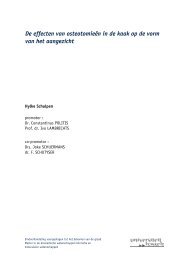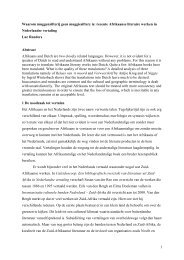Planning Problems in Intermodal Freight Transport ...
Planning Problems in Intermodal Freight Transport ...
Planning Problems in Intermodal Freight Transport ...
Create successful ePaper yourself
Turn your PDF publications into a flip-book with our unique Google optimized e-Paper software.
Integrated Simulation (HIS) and computer simulation based on a Petri-net model has been<br />
applied. This comb<strong>in</strong>ed approach takes both objective <strong>in</strong>fluences and human factors <strong>in</strong>to<br />
account. In this game approach human be<strong>in</strong>gs play the role of operators at the term<strong>in</strong>al. A<br />
study of operational rout<strong>in</strong>es for the transhipment process at <strong>in</strong>termodal term<strong>in</strong>als is also<br />
given by Marín Martínez et al. [41]. The authors <strong>in</strong>vestigate a set of operation modes for a<br />
gantry crane at a rail-rail term<strong>in</strong>al. A discrete event simulation model is built of a Spanish<br />
border term<strong>in</strong>al. Four operation modes are evaluated <strong>in</strong> a number of scenarios, vary<strong>in</strong>g crane<br />
characteristics, conta<strong>in</strong>er sizes and degree of coord<strong>in</strong>ation of tra<strong>in</strong> schedul<strong>in</strong>g. The authors<br />
prefer to recommend rules of operation <strong>in</strong>stead of generat<strong>in</strong>g the optimal solution for each<br />
particular comb<strong>in</strong>ation of tra<strong>in</strong>s because rules may be easier to implement <strong>in</strong> practice.<br />
4.3 Network Operator<br />
First, a network operator has to decide which consolidation network to use. Four basic<br />
types of consolidation networks are a po<strong>in</strong>t-to-po<strong>in</strong>t network, a l<strong>in</strong>e network, a hub-and spoke<br />
network and a trunk-collection-and-distribution network. Janic et al. [42] evaluate rail-based<br />
<strong>in</strong>novative bundl<strong>in</strong>g networks operated <strong>in</strong> the European freight transport system. Their<br />
objective is to identify promis<strong>in</strong>g or preferable network configurations which can <strong>in</strong>crease the<br />
competitiveness of <strong>in</strong>termodal transport. Indicators for network performance have been<br />
def<strong>in</strong>ed and quantified for selected bundl<strong>in</strong>g networks. The evaluation of consolidation<br />
networks is performed by means of the Simple Additive Weight<strong>in</strong>g (SAW) multi-criteria<br />
method. Newman and Yano [43] [44] compare a variety of decentralized plann<strong>in</strong>g approaches<br />
with a centralized approach for schedul<strong>in</strong>g tra<strong>in</strong>s <strong>in</strong> an <strong>in</strong>termodal network. The authors<br />
simultaneously determ<strong>in</strong>e an explicit direct and <strong>in</strong>direct (i.e. via a hub) tra<strong>in</strong> schedule and<br />
correspond<strong>in</strong>g conta<strong>in</strong>er rout<strong>in</strong>g decisions. The problem is formulated as an <strong>in</strong>teger program









